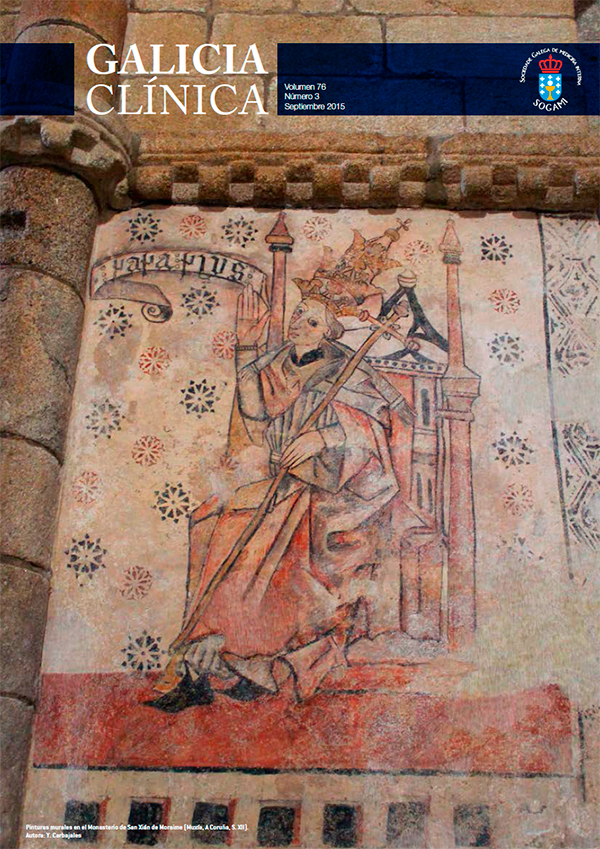Galicia Clínica by Sociedad Gallega de Medicina Interna is licensed under a Creative Commons Reconocimiento-NoComercial-SinObraDerivada 4.0 Internacional License.
Created from galiciaclinica.info.
Similar Articles
- Liliana Torres, Teresa Martins Mendes, Diana Pereira Anjos, Mari Mesquita, Tuberous sclerosis complex: an opportunistic diagnosis , Galicia Clínica: Vol. 80 No. 3 (2019): Galicia Clinica - Official Journal of the SOGAMI
- ROMEU PIRES, CRISTIANA BATOUXAS, TIAGO LOZA, PRUDÊNCIA VAZ, TRANSIENT ISCHEMIC ATTACK AS PRESENTATION OF CARDIAC MYXOMA , Galicia Clínica: Vol. 76 No. 2 (2015): Galicia Clinica - Official Journal of the SOGAMI
- Adrián Vázquez Mascato, Ana María Frade Fernández, Mercedes Paz Viña, Ricardo Calvo López, Clinical Characteristics and Resource Consumption of Patients Admitted and Discharged with a Diagnosis of Transient Ischemic Attack (TIA) , Galicia Clínica: Vol. 74 No. 3 (2013): Galicia Clinica - Official Journal of the SOGAMI
- Mª Dolores Fernández Couto, Alfredo Puy Nuñez, Transient Ischemic Attack: a great opportunity , Galicia Clínica: Vol. 74 No. 3 (2013): Galicia Clinica - Official Journal of the SOGAMI
- Andre Gordinho, Steeve Rosado, Adriana Soares, Maria Antunes, Multiple hematoma in young patient with sickle cell disease , Galicia Clínica: Vol. 79 No. 4 (2018): Galicia Clinica - Official Journal of the SOGAMI
- Rachid Bouchentouf, Acute ischemic stroke in a patient with disseminated tuberculosis , Galicia Clínica: Vol. 82 No. 3 (2021): Galicia Clinica - Official Journal of the SOGAMI
- Julio Montes-Santiago, Catalina Fernández-Méndez, Ricardo Guijarro-Merino, Carlos San Román-Terán, Manuel Monreal, Julio Montes Santiago, Ischemic stroke and symptomatic venous thromboembolism in Spain. Analysis of inpatients, economic burden and differences respect to clinical trials , Galicia Clínica: Vol. 70 No. 4 (2009): Galicia Clinica - Official Journal of the SOGAMI
- Cátia Ribeiro Santos, Cláudia Antunes, Isolated hand paresis due to ischemic stroke of the "hand knob area" , Galicia Clínica: Vol. 82 No. 1 (2021): Galicia Clinica - Official Journal of the SOGAMI
- Lilian Sousa, Vera Vieira, Cerebellar haemorrhage after cerebral venous thrombosis , Galicia Clínica: Vol. 79 No. 3 (2018): Galicia Clinica - Official Journal of the SOGAMI
- Nuno Zarcos Palma , Mariana da Cruz, Giant Pneumatocele , Galicia Clínica: Vol. 81 No. 3 (2020): Galicia Clinica - Official Journal of the SOGAMI
You may also start an advanced similarity search for this article.
Most read articles by the same author(s)
- Laura Castelo Corral, Soledad López Calvo, Ángeles Castro Iglesias, Pilar Vázquez Rodríguez, Laura Bello Rodríguez, Peginterferon alfa-2b and ribavirin in HIV-HCV co-infected patients: efficacy and safety in routine clinical practice. , Galicia Clínica: Vol. 71 No. 4 (2010): Galicia Clinica - Official Journal of the SOGAMI
- Ignacio Ramil Freán, Maria Fernandez López, Martin Vidal Vazquez, Clinical, epidemiological and outcomes analysis of COVID19 hospitalized patient on a mostly vaccinated population , Galicia Clínica: Vol. 83 No. 1 (2022): Galicia Clinica - Official Journal of the SOGAMI
- Laura Castelo Corral, Germán Bou Arévalo, Pedro Llinares Mondéjar, Practical recommendations for the diagnosis and treatment of urinary tract infection in adults (II) , Galicia Clínica: Vol. 74 No. 4 (2013): Galicia Clinica - Official Journal of the SOGAMI
- Ignacio Ramil Freán, Maria Vares Gonzalez, Joaquín Serrano Arreba, Acute hepatic bleeding in a patient treated with apixaban , Galicia Clínica: Vol. 80 No. 4 (2019): Galicia Clinica - Official Journal of the SOGAMI
- Beatriz Seoane González, Laura Castelo Corral, Fernando De la Iglesia Martínez, 2ª parte: manejo de la EPOC , Galicia Clínica: Vol. 70 No. 2 (2009): Galicia Clinica - Official Journal of the SOGAMI

